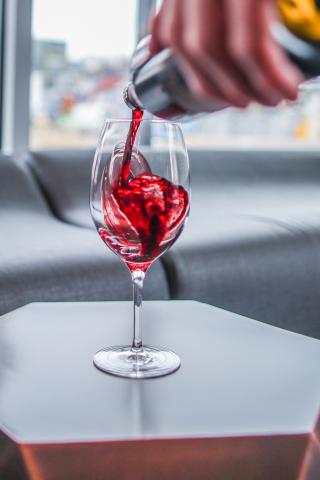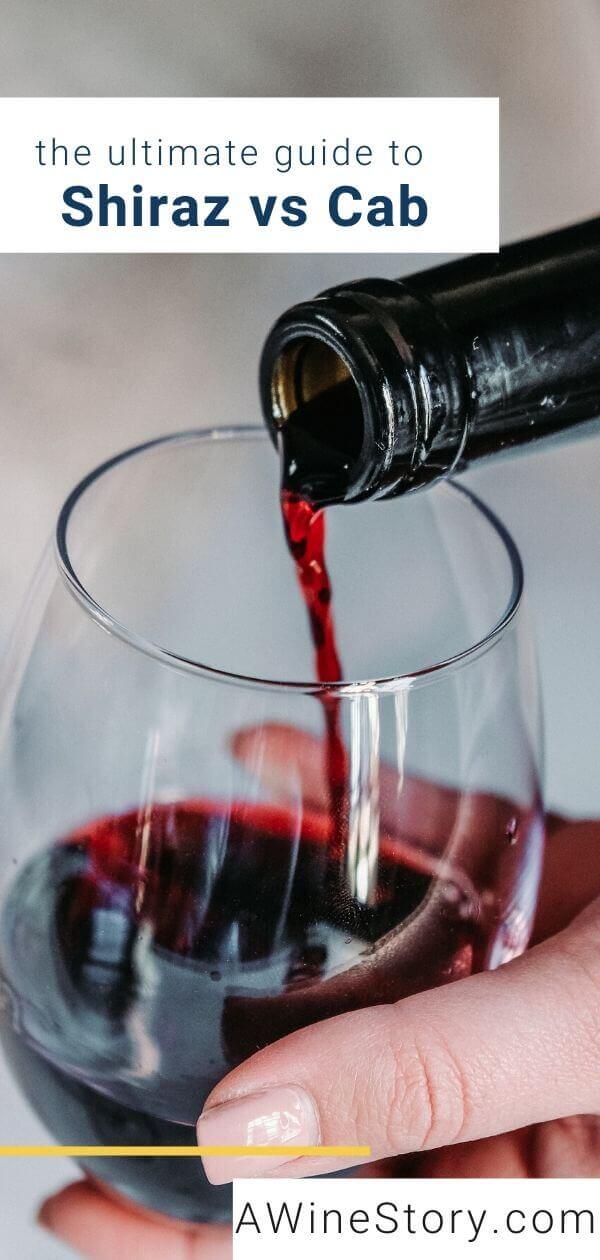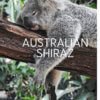3 Ways to Tell Australian Shiraz vs Cabernet Sauvignon
Every wine student faces the day that they must examine two wines blind.
The exam paper explains that they are two wines from the same wine region.
Nothing else.
Australian Cabernet Sauvignon and Shiraz are both very similar.
3 Ways to Tell Australian Shiraz vs Cabernet Sauvignon : The Distinctions
Even Masters of wine sometimes have trouble telling the differences between these two grape varieties.This is especially true when they come from the same region and vineyards close together.
**Click Here for Wine Resources**
Australian Shiraz vs Cabernet Sauvignon : Common Factors
1. deep purple color
2. very opaque color
3. firm evidence of oak
Note that in the past, the oak was American (a giveaway with its coconut aromas). Today increasingly French or a blend of French and American.
4. intense vinous aromas and flavors
5. black dominated fruit (blackberry, black fig, black plum, black cherry)
6. concentration suggests very ripe fruit (sunny climate).
7. concentration also suggests region with tradition of long maceration and fermentation
8. the “mint” aroma and flavor is typical of both Cabernet Sauvignon and Shiraz from Australia, especially McLaren Vale.
9. Both have elevated alcohol above 13.5, typical of both varieties of Shiraz and Cabernet Sauvignon.
10. Cabernet Sauvignon and Shiraz from these regions both have high acidity.

Australian Shiraz vs Cabernet Sauvignon : Differences
In Australia, the differences between these two varieties are less pronounced than elsewhere in the world.
I have in front of me Barossa Valley Estate Shiraz 2013 and The Cover Drive Jim Barry 2013 Cabernet Sauvignon.
Both Australian Shiraz and Cabernet Sauvignon wines are just under $20, designed to appear on the same place on the shelf and appeal to a similar customer.
“In an exam situation, it is important to tease out the differences between the two. Even though evidence may appear minimal.
In this scenario, I used private markers.
The Australian Shiraz sort of boldly announces itself in an outspoken, strident way as a jammy, fruit forward, “typical” Australian Shiraz
If a color could personify the wine, what would the color “purple” say about it? This wine has violet aromas, a light inky flavor, sharp pointed acidity, and a slight chocolate flavor.
By contrast, the Cabernet Sauvignon doesn’t have chocolate at all.
Australian Shiraz vs Cabernet Sauvignon : Worked Example
Recently I blind tasted two wines, both red. I was told they were the same varietal, but from two different countries.
Wine A had a very dark color, a black fruit and “inky” character, and over 14.5 abv. The fruit was very upfront. The oak was subdued … it was not American (no coconut, dill) but not a lot of spice and vanilla either.
And though the alcohol was high, the acidity was vibrant.
**Click Here for Wine Resources**
The tannins were structured.
It was a quality wine from a quality producer in the New World, but it was NOT California.
Or New Zealand.
As for the varietal, I went through the Bordeaux Varietals (Cabernet Sauvignon, Merlot, Cabernet Franc, Malbec, Petit Verdot) and then the Rhone Varietals (Syrah, Grenache).
Australian Shiraz vs Cabernet Sauvignon : Tough Call
Wine B was more restrained and elegant. The alcohol was much lower, about 13%.
While the varietal character threw me on wine A (Was it a Cabernet Sauvignon? A Shiraz?), in contrast Wine B had a much more varietal character in the sense of more intense ink, more intense violet, a subtle meaty character, and much more evidence of French oak.
I reckoned about 10 – 15% to be new from the hint of vanilla.
What struck me most were the silky tannins and very dense texture of the wine. And then that meaty quality juxtaposing against the violet aroma.
Even without going through the deductive analysis I instinctively knew it was French. I instinctively felt it was from the Rhone.
And though the wine was well made, with great attention to detail and quality, it was not distinctive enough for me to call it an Hermitage, a Cornas, or a Cote-Rotie.
Therefore either a larger appellation like Saint Joseph or Crozes-Hermitage.
In general – all things being equal – when I am buying Syrah in a shop I would tend to go for Saint Joseph over Crozes-Hermitage unless I was very familiar with the producer.
In this case, the wine B turned out to be the 2016 Crozes-Hermitage from Alain Graillot
Yes, that black olive (very concentrated) lots of earth, truffle, and spice. blackberry, black pepper fruit and briny, meaty black olives, licorice, herbs
Australian Shiraz vs Cabernet Sauvignon – The Reveal
Wine A: The Cunning Plan Shiraz, Langhorne Creek 2016 McLaren Vale (tech notes below
Wine B: 2016 Crozes-Hermitage from Alain Graillot
Small French producers do not usually have technical sheets about their wines.
I would continue to say this has 10 – 15% new French oak, aged for 11 – 13 months.
It’s drinking well now and should hold for another 6 – 7 years.
Australian Shiraz vs Cabernet Sauvignon :The Cunning Plan Shiraz, Langhorne Creek 2016 McLaren Vale
The flood plains between the Angas and Bremer rivers have long been home to some of South Australia’s best fruit.
The best Langhorne Creek crop goes into The Cunning Plan.
This region tends towards later ripening than the Barossa or McLaren Vale.
And the result of using ripe fruit at lower sugar levels gives the wine better alcohol balance.
Australian Shiraz vs Cabernet Sauvignon Winemaking
Winemaking involves just ripe fruit.
Gentle picking.
4 days to extract color, aroma and fruit.
All this prior to the alcoholic fermentation,
Following the alcoholic fermentation, the wine is pressed off to 300 litre used French barrels.
Here it it matures for 10 months prior to bottling.
Australian Shiraz vs Cabernet Sauvignon : Tasting
Great depth of ripe plum and blackberry fruit flavours. A full bodied wine with a succulent palate, lively spices and fine velvety tannins.
Stay tuned for “Cheat Sheets” for these two Varieties!
Please SHARE this article visit the social media links and subscribe to my newsletter here
If you like this article you will like:
— Dominus Estate
— Chappellet Family Winery
— Hess Collection
— Frog’s Leap
Curious to Learn More About Wine? Start Here
Want to Grab Quick Wine Resources? Click Here
About Author Marisa D’Vari
D’Vari contributes to Forbes.com, Financial Times, World of Fine Wine, Quarterly Review of Wine, Decanter Robb Report, San Francisco Chronicle, South China Morning Post, and more.
She holds the (WSET) diploma, Certified Sommelier through the Court of Master Sommeliers, a Certified Wine Educator through the Society of Wine Educators … to see it all, please click on bio
Love Gary V? Watch him taste these wines blind on a Youtube Video


